Secrets of the American Flagfish
From Microcosm Aquarium Explorer

- Jordanella floridae, an underappreciated Florida species. Matt Wittenrich
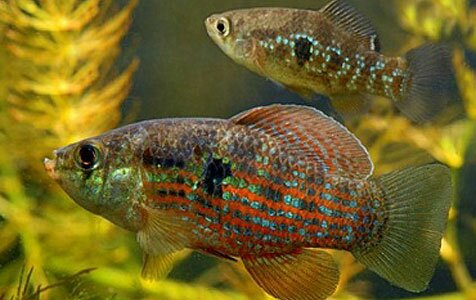
- The male below and the female above. Matt Wittenrich
Surprises Galore When Breeding A Native Killifish
American Flagfish, Jordanella floridae, are the subject of much controversy, having caused many differences of opinion among people who have kept them. They present us with many moods and contradictions. Even after four years of interested observation and much reading, I sometimes have to question whether a statement I am about to make about them is really truly true. What clever creatures these are!
For those who collect such facts, the genus name, Jordanella, was erected in honor of David Starr Jordan, the first president of Stanford University, and the species name, floridae, is a nod to the state of Florida, where they are particularly abundant in the swamps, canals, ponds, etc., both brackish and freshwater. The St. Johns River is where J. floridae was first collected. (See modern-day intrepid collector Matt Wittenrich capturing fish in the St. Johns River for this article: Tracking the Elusive Flagfish.
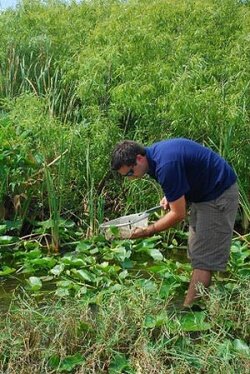
Quirky Fish
That’s pretty straightforward, but what seems to indicate a touch of quirkiness and uniqueness in these creatures is that the species floridae is the sole member of the genus Jordanella.
The American Flagfish, or Flagfish, is a North American native killifish and one of a rare handful of American pupfishes. Jordanella floridae is the most frequently sold of these active and hardy fishes. It is closely related to the Yucutan Pupfish, Garmanella pulchra, which was originally described in Jordanella as well, but has since scored its own separate genus.
Flagfish Flying Colors
When viewed under proper conditions, and especially in breeding colors, both the male and the female are quite attractive. They are not particularly photogenic, however, and I have yet to see a photo that really does them justice. (Until now!---mes) These are small (2.25 inches [6 cm]), chunky fish with a particularly bulldog-like profile. Their fins are rounded and full with the dorsal and anal occurring far back on the body and meeting the tail fin. The female has a definite spot on her side and a crisp spot toward the rear of the dorsal fin that is bordered in opaque white. The slight red coloring in the fins comes and goes for no apparent reason. Otherwise, she is marked with a subdued olive checkerboard-like pattern highlighted with turquoise scales that is similar to some of the female dwarf cichlids.
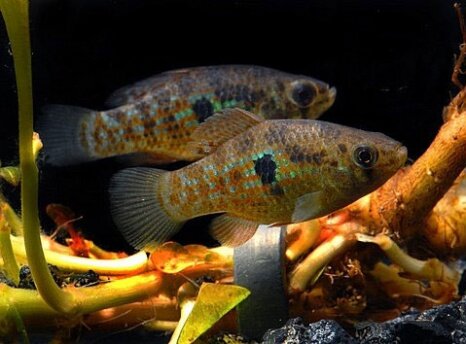
It is from the male that the fish derives its common name, American Flagfish, and this description does not require too much imagination. Over the shoulder is a dark rectangle that could easily be seen as the field of blue with white stars and the sides of the body are striped in red and “white,” which is actually more green, but stet the metaphor, because when you do see a breeding male, it will be his perky glow that inspires, not his ever-changing color scheme. There is a dark spot mid-body at the lower right corner of the dark rectangle. Under the pattern and colors on the dominant male, the olive-gray coloration and pattern that attire the sub-dominant male, female, and juvenile can be seen.
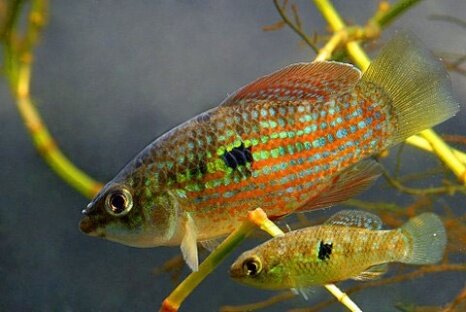
When viewed under unsuitable keeping conditions, the American Flagfish hardly resembles any of the glowing descriptions given. Except for size and form, we might as well be looking at another species.
Even the shape of an unhappy J. floridae is miserable, with their ordinarily full, rounded and butterfly-busy fins being clamped close to the body and compressed. When we hear that these fish are nothing to write home about, we can be sure that they were sick or kept in a too-bright tank with no hiding places and light-colored gravel. These little chameleon-like fish will try to blend in wherever they find themselves.
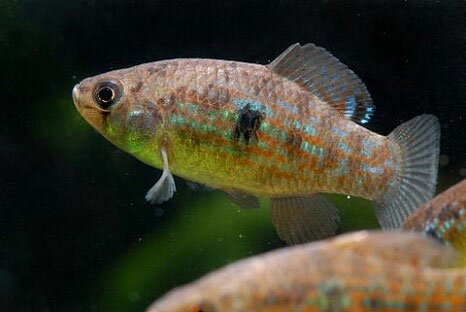
Where they truly prefer to be is totally out of sight until things get especially quiet. This makes sense for a chubby little fish that makes a nice mouthful for the many predators in their native range. They cannot stand to be kept in a tank with a light substrate, even lighter-colored natural gravel sends turns these normally feisty little fish into timorous filter huggers.
Ditto for bright lights without floating plant cover. But when the bottom is darkened and there is limited light from the sides and above, then they will dart about the lower third of the aquarium, pursuing the occupation of the Flagfish, which is feeding on plant detritus, algae and small worms and insects. This is partly why Java Moss is so good with these Flag Fish; it conforms to their preferred design in short order. As the mat of moss gets thicker, the fish feel more secure and behave more naturally.
Feeding the American Flagfish
Flagfish will often destroy soft-leaved plants, but this seems to be a reaction to too much open space in the tank. As primarily vegetarian fish, they will eat soft spirulina food, pleco-style wafers, par-boiled zucchini bits, etc., and prefer to take their foods from the bottom of the tank. They work the glass and sponge filter for microscopic particles pretty consistently, and will even take choice items like freeze-dried bloodworms, blackworms, and brine shrimp from higher in the water column. They do keep a very clean tank, and if a spot of algae develops, cut down on the food for a few days, and the Flagfish will usually go to work on it.
Sex and the American Flagfish
We’ve got babies. A three-quarters grown female Flagfish turns up in a 20-gallon, Java Moss filled lower-level aquarium. Removal of the mat of Java Moss reveals a second baby, this time a half-grown female. Eureka! The balance of power has finally shifted in the tank from a single pair to a trio of females and one male. The pair that had been left in the tank to peacefully live out their days had belatedly provided for posterity. This surprised me, as these cyprinids should only have a lifespan of about one year. Here, after three full years, was evidence that not only had they trebled their wild life expectancy, but they had remained fertile.
The adults are survivors of a school of eight juveniles “rescued” from a Floridian pond. There had been several spawns, but as there was only one female to seven males, it was an awkward arrangement at best. While it would seem that there was too much posturing by the dominant male for any real sexual activity to occur, there had actually been several spawns right after the fish moved into the tank.
Where Art Thou, Flagfish Fry?
Segregating the pair did not afterwards reveal any youngsters through two full seasons. I had little doubt that there was spawning going on---the dominant male would often show up at the front glass in full spawning regalia---but there were never any fry observed. The male Flagfish may guard and care for his offspring, but he will just as soon eat the eggs or the juveniles if there are other predators (including the female) on the prowl and even if there aren’t.
In order to view the newly discovered young in the 20-gallon, I lifted the solid mat of Java Moss into a clean dishpan and covered it with water in case there happened to be other juveniles trapped in the moss. The pan was put aside and I planned to divide it up into other tanks later.
Set Up for Success
This well-aged 20-gallon tank has a reasonable amount of Java Moss, one male Flagfish, three female Flagfish, a sponge filter, heater, dark gravel bottom, and a few snails (not many for such a snail-friendly tank, which leads me to suspect that the Flagfish like a little escargot or maybe just escargot caviar). The lights are kept on 14 hours a day; the temperature is 72ºF; and the water chemistry is generally hard and alkaline with a pH in the 7.2 to 6.9 range. Aquarium water is used to water houseplants and this ensures small, frequent water changes. There is some brown algae on the back and sides of the tank and there is a bit of mulm on the gravel. Filtration is provided by a large sponge filter that is rarely squeezed and which the female uses as a barrier and source of snacks.
Courtship, Egglaying, and Paternal Care
There is a courtship dance, part of which is quite amusing. The female tags the male and darts away. He follows and with her facing him, he stops, and does a slow-motion backward flip. This theater goes on nightly. After their dance, the pair swim closely and the female drops about 20 eggs that are fertilized by the male.
There is every evidence that the male guards the eggs with great ferocity. He is the problem fish who causes the ripped fins and wounded egos when the Flagfish is kept in community tanks. If you want to keep them communally, keep a single male or only males or only females. In these proportions, you will not have any trouble with them in a peaceful community.
Though the male is a great egg-watcher, fanning and protecting the eggs, he is also a cannibal, so it is best to remove him if you see a spawn of wrigglers, which is unlikely unless you are keeping the fish in a very clear tank. The eggs take from four to nine days to hatch, depending on temperature. To save the fry, remove the moss (or spawning mop) under where the male is stationed. This material will usually harbor the bulk of the eggs or fry.
In the time since I first wrote this article, I have added Moss Balls, Cladophora sp. to the Flagfish aquarium. What perfect Flagfish nurseries these little Moss Balls are!!! The dominant male has no trouble luring females to this very nice nest for spawning, and he looks very handsome as he guards the eggs that are so nicely cradled in the moss. This is a perfect medium for spawning Flagfish.
Remember that pan of Java Moss I harvested from the flagfish tank to look at the big fry? Three or four days later, I decided to distribute it among other tanks. Neptune stayed my hand, and I peered into the moss before dividing it up into other tanks. The bottom of the pan was alive with fry! Perhaps 100 J. floridae fry scattered from the sunward-facing corners of the pan into the moss when I looked down into the shallow water. Eureka!
Growing Up the Flagfish Fry
They are feeding well on infusoria and baby brine shrimp and seem to grow daily though they start out as very small fry. They are not particularly delicate, but they do need tiny foods for several weeks. The cupboard for these tiniest of fry includes green water, liquid fry food, APR, etc., and will be needed until they are large enough for the brine shrimp and other standard baby fish foods. I have since divided the spawn into several pans to give them plenty of room. They will grow out with a variety of foods as their size will accommodate. It just goes to show, no matter what we think is going on, the fish still have the ability to surprise us.
See also: American Flagfish








